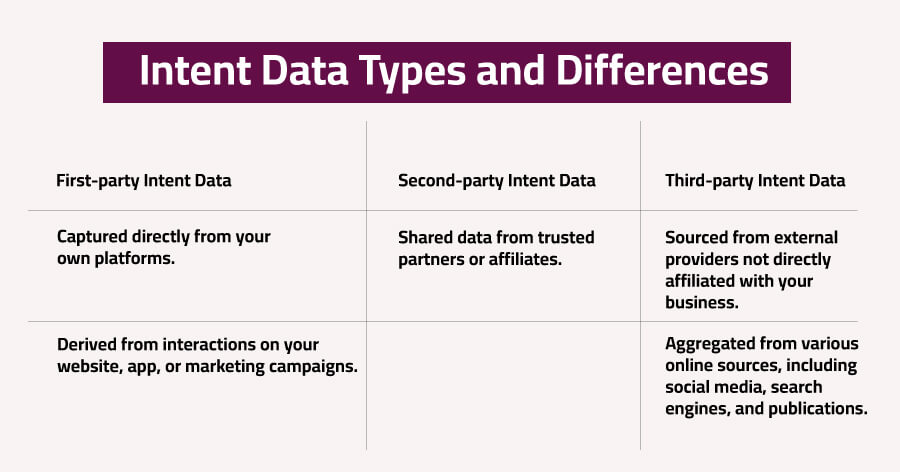
Tele Intent™ Data: The Secret Weapon You Didn't Know You Had!
Today, data-driven marketing strategies are on trend. Most businesses move toward third-party intent data as a way to adapt it. This move is obvious as 78% of customers like buying from a brand if they respond to their inquiries first. Intent data gives you enough details to make it happen.
However, due to third-party intent data’s lack of real-time insights, competitors may win your target clients.
Not good, right?
Thus, the desire for an innovative solution to extract intent signals arises more than ever.
"Tele Intent™ Data" is a potent force to meet this demand. It gives you insights on why and what your prospects want, and that too in advance.
So, let's learn how it works!
But, before that, we’ll delve into the intricacies of third-party intent data: its limitations and claims.
Why Third-Party Intent Data Won't Cut Through Today's Marketing Needs
Third-party intent data originates from external sources (like publishers or data providers), providing insights into potential buyer interests and behaviors, unlike:
- First-party data (your own customer data)
- Second-party data (partner-shared data)
- Zero-party data (voluntarily provided by customers)

One common misconception is that third-party data offers comprehensive insights into customer intent. However, it's often aggregated and lacks context, leading to less accuracy and relevance. While it can supplement your understanding, it shouldn't be solely relied upon.
Here are some of its major limitations:
- Third-party data has limitations regarding freshness, accuracy, and relevance. It may not capture nuanced buyer behaviors or changes in real-time, impacting the effectiveness of marketing campaigns. Combining data sources, including first-party insights and qualitative research, is essential to understand your audience and tailoring strategies effectively.
- There's the illusion that site visit data can be fully "de-anonymized" to reveal genuine intent. In reality, many site visitors might browse casually, not necessarily indicating genuine interest in your product or service.
Moreover, the 95:5 rule suggests that only a small percentage of website visitors strongly intend to purchase. It means relying solely on third-party intent data may lead to missed opportunities and ineffective marketing strategies.
While third-party data has its limitations, it can still offer valuable insights. All you have to do is use it in conjunction with other data sources and qualitative research methods, such as:
- Interviews
- Focus groups
- Observational research
- Case studies
- Ethnographic studies
- Content analysis
- Narrative analysis
- Grounded theory
- Phenomenological research
- Action research
However, enriching third-party data is both time-consuming and tiring.
Plus, you may risk losing potential clients if your competitor manages to reach them first.
Thus, you need a revolutionary solution to leverage intent data at its best: enter Tele Intent™ data.
How Tele Intent™ Brings a New Paradigm in Intent Data
Tele Intent™ Data is a new way of gathering prospects' information in B2B marketing. Instead of collecting basic data from online interactions, it analyzes real conversations with potential clients during prospecting calls. It helps you to understand their needs and preferences better.
This method goes beyond traditional ways of collecting data by looking at both:
- What the prospect said in real-time
- The context in prospect said it
Thus, it minimizes the gap between your prospect's current intent and the time you take to offer customized marketing offerings.
As 99% of major corporations leverage intent data, you can step ahead of them with this advanced version of information collection.
Now, let us understand how this approach works.
Is Tele Intent™Ethical and Practical?
It is essential to gather prospects' data with their consent and handle it by respecting their privacy and confidentiality.
Tele Intent™ experts ensure they adhere to regulations such as:
- Telephone Consumer Protection Act (TCPA)
- CAN-SPAM Act
- General Data Protection Regulation (GDPR)
- Do Not Call (DNC) Registry maintenance
Hence, using Tele Intent™ Data is safe for your marketing purposes.
Tele Intent™ Implementation in Your Marketing Strategy
Here's how Tele Intent™ professionals collect valuable data from the prospects:
- Performing Prospecting Calls: Skilled professionals call potential clients to get them talking about their needs and worries.
- Extracting Data: Using smart analysis, experts carefully study these conversations to find essential signals about what the clients want.
- Generating Insights: Data professionals then turn these signals into valuable tips. Thus, you can use the insights to make your marketing plans more accurate with the help of data.
- Segmenting High-Value Prospects: Experts determine where customers are in their decision-making process. To do so, they consider factors like timing and how relevant the information is.
Best practices for leveraging direct engagement for intent analysis:
- Keep questions concise and offer incentives to encourage participation.
- Listen attentively to the prospect's responses, tone, and language to gauge their interest and intent.
- Encourage prospects to freely share their challenges, goals, and pain points, allowing for deeper insight into their intentions.
- Use qualifying questions to determine if the prospect aligns with your target customer profile and if they demonstrate genuine interest or potential need for your product or service.
- Pay attention to non-verbal cues such as pauses, tone of voice, and enthusiasm, which can provide additional context about the prospect's level of engagement.
- During the call, offer relevant insights, solutions, or resources to demonstrate your expertise and build trust with the prospect.
- After the call, follow up promptly with personalized information or resources that address the prospect's specific needs or interests discussed during the call.
- Record key takeaways and insights from the call to inform future marketing and sales strategies and improve your understanding of prospect intent over time.
How Tele Intent™ Data Can Transform Your Business After Implementation
In B2B marketing, understanding your potential clients' specific needs and concerns is crucial. Tele Intent™ Data provides more precise and relevant insights into these aspects.
Thus, it empowers your business to tailor its strategies and communications more effectively.
Here's how Tele Intent™ Data helps you:
- Enhanced Lead Qualification: You can quickly identify which leads are genuinely interested and understand why. It allows you to develop more focused and effective follow-up strategies, saving time and resources.
- Tailored Content Creation: You gain the ability to craft highly relevant content that resonates with your audience with Tele Intent™ Data. Hence, it increases your marketing efforts' engagement and conversion rates.
- Enhanced Customer Experience: You can leverage predictive customer support using Tele Intent™ Data. Thus, you can anticipate issues before they arise, ensuring proactive resolution.
Further, you can provide personalized services and recommendations based on individual preferences. It leads to customer loyalty.
Additionally, you can optimize and allocate your resources efficiently and proactively. It resolves issues to maximize network performance and reliability. Thus, it enhances your organizational efficiency and customer experience. - Business Intelligence and Strategy: You can conduct market trend analysis to stay ahead of the competition with Tele Intent™ Data. Hence, it gives you a competitive advantage through data-driven decision-making.
Such comprehensive data empowers you to make informed strategic choices that drive business growth and success.
Conclusion
Tele Intent™ Data can take your B2B outbound marketing to the next level. Its precise insights can help you process tailored strategies to reach high-value prospects quicker than traditional intent analysis. But remember to use this data responsibly and ethically.
This is where Revnew, specializing in Tele Intent™ Data, helps you optimize your business strategies without compromising compliance. Discover how we can elevate your marketing efforts by filling out the form for a discovery call with us.
Let's empower your business together!
FAQs
What sets Tele Intent™ Data apart from traditional intent data?
Tele Intent™ Data stands out from traditional intent data by focusing on real-time, person-to-person interactions instead of relying solely on digital footprints like website visits or download histories. This approach offers a more nuanced understanding of potential customers' intentions and needs.
Why is Tele Intent™ Data crucial for B2B marketing?
The data is significant in B2B marketing because it provides precise insights into potential clients' needs and concerns. This deeper understanding enables businesses to tailor their marketing strategies and messaging more effectively, increasing relevance and engagement.
How can businesses leverage Tele Intent™ Data?
Businesses can harness Tele Intent™ Data to refine lead qualification processes, personalize marketing campaigns, and stay ahead of emerging market trends. By integrating this data into decision-making processes, businesses can align their strategies more closely with customer needs, leading to more impactful outcomes.
What advantages does Tele Intent™ Data offer sales teams?
For sales teams, the data offers invaluable insights into potential clients' context and specific requirements. This knowledge enables sales representatives to craft more targeted and persuasive pitches, ultimately increasing the effectiveness of their sales efforts.
Additionally, Tele Intent™ Data aids in prioritizing leads based on their level of intent, allowing sales teams to focus their resources more efficiently.
Who stands to benefit from Tele Intent™ Data usage?
The data presents opportunities for any B2B organization seeking deeper insights into their target clients and market dynamics. Its benefits are particularly pronounced in industries characterized by complex and rapidly evolving customer needs, where precise understanding and responsiveness are essential for success.
How is third-party data collected?
Data collection involves companies acquiring data from sources without a direct relationship with their target audience. Marketers typically procure this data through purchases or licenses from reputable providers. Alternatively, they may employ cookies and website tracking tools to gather information about the online activities of their desired audience.
What is the process of sharing third-party data?
Data aggregators facilitate the sharing process. These entities gather data from diverse sources, categorize it based on various criteria (such as industry, demographics, or specific data attributes), and make it available for purchase. Depending on your needs, the data acquired could fall into any relevant use category, determined by the specifics of your purchase.
What are the potential risks associated with third-party data?
There are several risks associated with third-party data, such as:
- Operational Risks: These stem from the possibility of operational disruptions caused by actions taken by third parties.
- Cybersecurity Risks: Third parties are frequently targeted by cyber attackers, posing a risk to the security of the shared data.
- Compliance Risks: Failure by a third party to implement adequate security measures can result in data breaches, leading to compliance issues and potential data loss.




